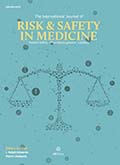Authors: Sridharan, Kannan
Article Type:
Research Article
Abstract:
BACKGROUND: Patients undergoing dialysis pose therapeutic challenges in terms of polypharmacy, administration of potentially inappropriate drugs, and drugs with the potential risk of toxicity. OBJECTIVE: This study evaluated the use of drugs, potentially inappropriate medicines (PIM), drugs with risk of Torsades de Pointes (TdP), and the complexity of the prescribed regimen using the medication regimen complexity index scale in patients undergoing hemodialysis. METHODS: A retrospective cohort study was carried out amongst patients receiving hemodialysis. Drugs were classified into one of four classes: (i) drugs used in managing renal complications, (ii) cardiovascular drugs, (iii) anti-diabetic drugs, (iv)
…drugs for symptomatic management, and (v) others. Drugs were considered as PIM according to the Can-SOLVE CKD working group from a network of Canadian nephrology health professionals. The study adhered to the CredibleMeds classification of drugs with known, possible, and conditional risk of TdP and the complexity of prescribed medicines was evaluated based on the pre-validated medication regimen complexity index scale based on form/route, frequency of dosing, and requirement of special instructions. RESULTS: Sixty-three participants were included in the study (49 males and 14 females) with the median (range) age of 45 (21–66) years. Cardiovascular drugs followed by drugs used for managing renal complications were the most common classes administered. Notably, 12 (19.1%) patients received one of the non-steroidal anti-inflammatory drugs, 21 (33.3%) received a proton pump inhibitor, three (4.8%) received pregabalin, two (3.2%) received opioid drugs, and one (1.6%) was administered celecoxib. Atorvastatin, furosemide, omeprazole, and allopurinol were the most common PIM drugs administered to the study participants followed by others. Drugs used for symptomatic management had significantly more PIM compared to other classes (p < 0.0001). Six (9.5%) patients received drugs with known TdP risk, one with possible TdP risk, and 61 with conditional risk. Median (range) medical regimen complexity index score was 26.5 (2–62.5). CONCLUSION: A huge burden of drug therapy was observed in the hemodialysis patients in terms of higher proportions of PIM, complex medical regimen, and prescription of drugs with risk of TdP. Implementation of clinical decision support tools enhancing rational prescription and identification of drugs with TdP risk, introducing antimicrobial stewardship, and stepwise deprescription of the drugs with the least benefit-risk ratio are warranted.
Show more
Keywords: DUS, ESRD, chronic kidney disease, dialysis
DOI: 10.3233/JRS-230004
Citation: International Journal of Risk & Safety in Medicine,
vol. Pre-press, no. Pre-press, pp. 1-11, 2024
Price: EUR 27.50




